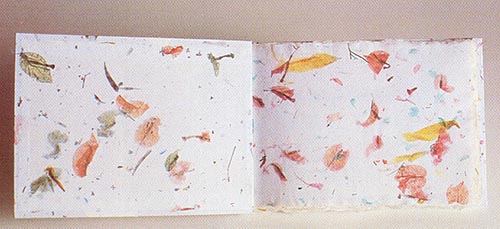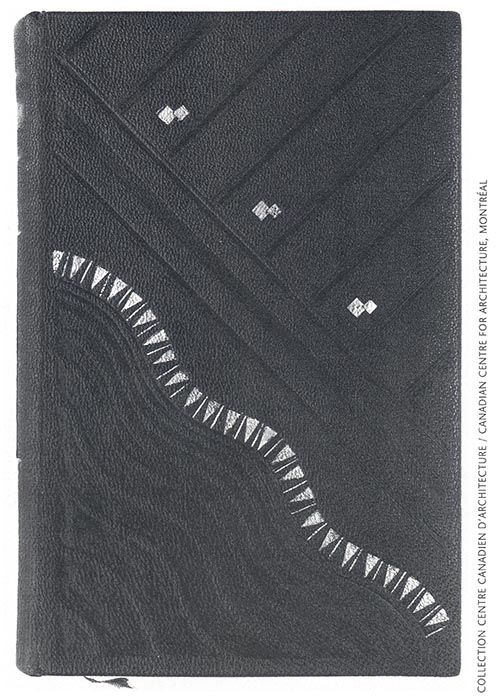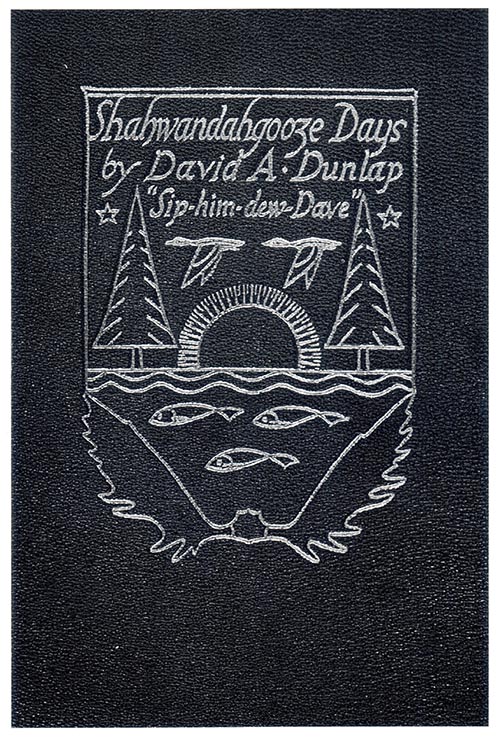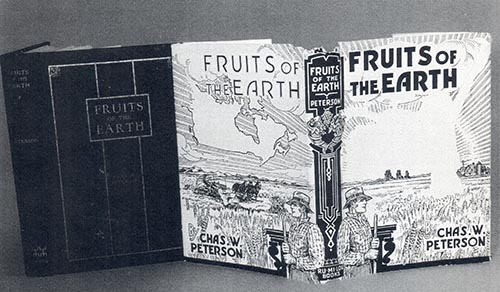Foreward | Acknowledgements | Exhibition Schedule | Le calendrier d'exposition
BINDING: One of the first Canadian book arts/L'un des premiers arts canadiens du livre: LA RELIURE
Jurors' Comments/Commentaires des Jurés & Jurors' Work/Pièces des jurés | Prize-winning Entries/Gagnants des prix
Artists' Books/Livres d'artiste | Calligraphy/Calligraphie | Decorated Paper/Papier Décoré
Fine Binding/ Reliure d'art | Fine Printing/Typographie | Handmade Paper/Papier main
Exhibition Schedule/Le Calendrier d'Exposition
Triangle Gallery of Visual Arts
January 21 - February 26, 1995
Glenn Goluska | Canada
1988 Juror/Juré 17.9 x 12.7 x.5 cm
| Each copy has a different combination of stick-on vinyl letters. Binding by Anne Sutherland. |
Chaque copie porte une combinaison de lettres de vinyle adhésif. Relie par Anne Sutherland. |
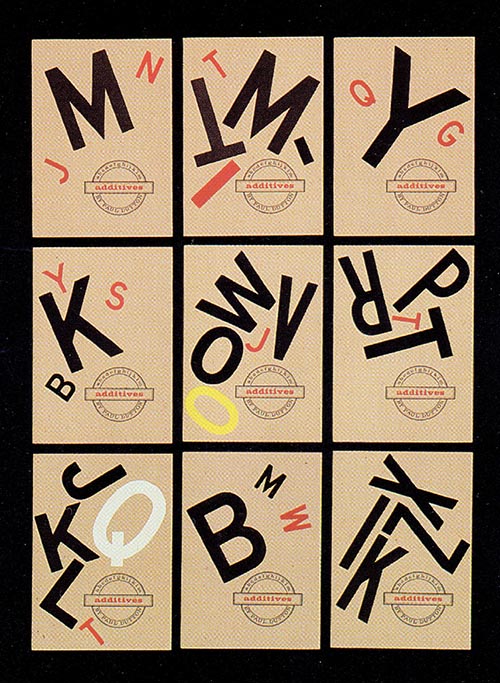
Glenn Goluska
An exhausting but enjoyable weekend. The most confusing and frustrating category was that of Artists' Books, which needs clarification or maybe even division into two categories (Books by Artists & Livres d'artistes?). But certainly some guidelines are needed for those submitting work. As it was, it seemed a catch-all for books that fit in no other category or should probably not have been entered in the first place. Encompassing everything from mass-produced trade paperbacks, to boring blank books, to exciting blank books (which ended up moved into Fine Binding), to handmade photo albums with or without artistically-redeeming-value, to lavish livres d'artiste: this category made comparisons almost impossible. Also, it's the one category where one is most forgiving of less-than-perfect technique: it would be nice to see more fun and experimentation, more zaniness. But, all in all, tables loaded with wonderful objects that it was a pleasure to handle and that make me eager to finally get my presses moved and start printing again. And two co-jurors, Susan and Don, who were a pleasure to work with. |
Une fin de semaine fatiguante mais satisfaisante. La catégorie la plus indistincte, frustrante, c'était celie des Livres d' artistes; elle manque du clarification, iI faudrait peut-être la diviser en deux catêgories, comme par example Books by Artists et Livres d'artistes? Ceux qui soumettent des Livres d'artist ont besoin de critères sûres, sinon cela devient une collection incohérente de livres qui n'appartiennent pas à une catégorie particulière, qui n'ont vraiment pas de place dans l'exposition. Cette catégorie comprenait des livres brochés fabriqués en sérée, des livres blanc peu intéressants et leurs contraires que nous avons réclassés Reliure d'art, les albums fait à la main so it avec ou sans intérêt artistique, des Livres d'artiste luxueux: une gamme qui défiait toute comparaison. C'est aussi la catégorie qui permet un peu d'indulgence quant à la technique; j'aurais espéré plus de frivolité d'expérimentation, de folie. En fin de compte, les tables ployaient sous Ie poids des créations merveilleuses, et c'était ungrand plaisir de les manipuler, me stimulant de recommencer mon travail de typographie. Travailler avec mes deux collègues, Susan Warner Keene, et Don Rash, m'a beaucoup plu. |
![]()
Susan Warner Keene | Canada
Juror/Juré 27 x 21 cm
| Handmade paper, flax, and abaca. | Papier main, tin, et abaca. |
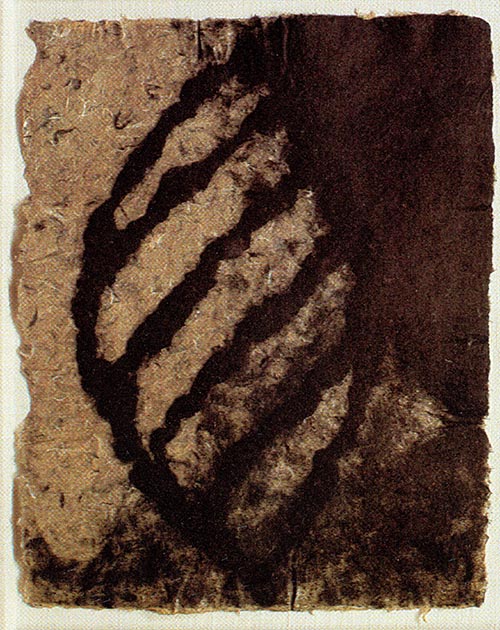
Susan Warner KeeneIt is fascinating to me that, in an electronic age when, from time to time, the demise of the book form is predicted, this exhibition attracted so many entries. The fact that the category of Artists' Books was by far the largest suggests that the potential of the book for communicating in a very particular way is far from being exhausted and is, in fact, appealing to more and more individuals. Selecting the requisite number of pieces for exhibition was often difficult because of the generally high quality of the entries, and given more space in the catalogue and in the touring crates we could probably have included several more. This is one of the frustrations of the juror (and, I am sure, the exhibition organizer). In making tough choices, I was guided by the apparent intention of the work, the quality of design or concept, and the skill with which the work had been carried out. The book arts today embrace diverse traditions, skills, and intentions, and consequently bring together creative people from vastly different areas of the visual arts: printmakers, photographers, papermakers, sculptors, calligraphers, textile/fibre artists, paper decorators and, of course, bookbinders. The exhibition reflects this rich diversity and will, I hope, confirm for the viewer that the book is alive and well and possibly even more interesting than previously imagined. |
Je le trouve fascinant que, dans cette époque électronique, où de temps en temps, en prévoit requlièrement l'extinction du livre, une telle exposition engendre tant d'intérêt, Le fait que le Livre d'artiste a prédominé est suggestif du potentiel du livre en tant que mode de communication, loin d'être exhausté et qui par contre continue d'attirer les gens. Selectionner Ie nombre de pièces requis était souvent difficile à cause de la haute qualité des oeuvres; s'il y avait plus de place dans Ie catelogue ainsi que dans les caisses de transport, on en aurait probablement choisi davantage. Ceci est une des frustrations du jury (et, sans doute de l'organisateur de l'exposition). Afin de prendre ces décisions difficiles, je me suis laissée guider par l'intention apparente de l’artiste, la qualité du dessin ou du concept, et l'habileté technique de l'artiste. Aujourd'hui les arts du livre renferment diverses traditions, capacités, et intentions et par conséquent rapprochent les créateurs de secteurs extrêmement différentes des arts visuels: typographes, photographes, fabricants de papier à la main, sculpteurs, calligraphes, artistes en tissu/fibre, décorateurs de papier et bien entendu relieurs. L'exposition relève cette magnifique variété et j'espère qu'elle va parler au spectateur de la vitalité du livre, un objet qui continue d'évoluer de façon de plus en plus intéressante. |
![]()
Don Rash | United States
1991 Juror/Juré 35.5 x 26 x 6.3 cm
| Dark green full Cape Morocco, two raised bands, top edge gilt, sprinkled edges, and endpapers by binder, applied gold leaf, gold, and pigment tooling. | Plein maroquin "Cape" vert foncé, sur deux nerfs, tranche de tête dorée, tranches, et gardes colorées par l'artiste, or en feuille, décor dorure à chaud, et à la peinture. |
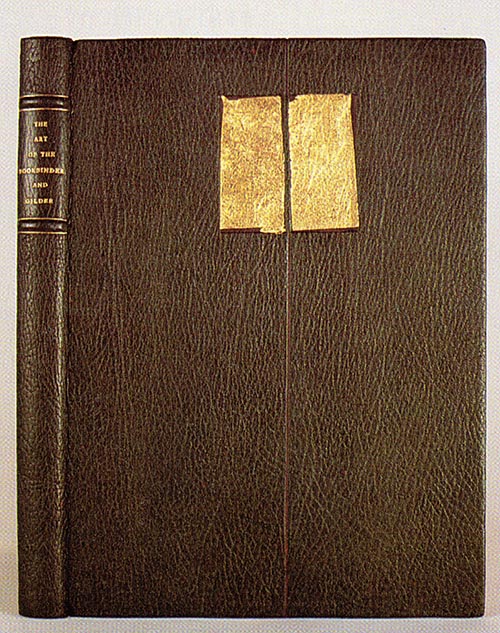
Don Rash
While being asked to act as one of the judges for this show was very flattering, the actual jurying process could generously be described as challenging. Exhausting also comes to mind as an appropriate adjective. This year there were twice as many entries as for the fifth anniversary exhibition, and the overall quality of submissions was high. Thus, to edit a field of 280 works down to about 80 was a rigourous task, not to be undertaken by the faint of heart. All joking aside, the members of CBBAG have made it possible to mount a definitive exhibition of current book arts, and should be proud of their achievement.
|
|
HENRY N.R. JACKMAN FOUNDATION AB93 AWARD FOR BEST IN SHOW
Don Taylor | Canada
1992 Boxmaking/Boîte 28 x 37 x 6 cm Carton, tissu, papier, cuivre, perles.
| Board, cloth, paper, copper, beads. | Carton, tissu, papier, cuivre, perles. |
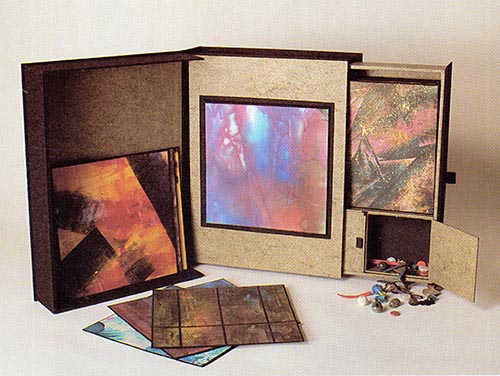
![]()
THE JAPANESE PAPER PLACE AB93 AWARD FOR ARTISTS BOOK
Susan Mills | Canada
1992 Artists' Books/Livres d'artiste 23 x 40 x 1 cm
| Bark paper, plexiglass. | Papier d'écorce d'arbres, plexiglass. |
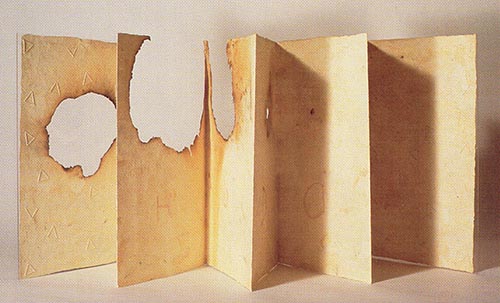
|
As an artist, I work with an awareness and respect for poetry, visual art, and the craft of bookbinding. The book form allows words, images, and materials to interact cohesively. When a book is picked up, handled, and read it invites a response to the gap between conception and experience; it speaks of a journey from here to there. As a hand bookbinder, I enjoy the everyday practice of craft and the chance to teach it to others. |
métier de la reliure. Le livre est de caractère à permettre aux mots, images et matéiaux d'agir réciproquement et cohésiverment. Quand on prend un livre entre les mains, le manipule, le lit, c'est une invitation à répondre à l'écart entre la conception et l'expérience, un voyage d'un point à l'autre. Comme relieur, j'aime bien pratiquer mon métier chaque jour et avoir l'occasion de l'enseigner aux autres. |
![]()
WOOLFITT'S ART ENTERPRISES AB93 AWARD FOR CALLIGRAPHY
Nancy Ruth Jackson | Canada
1988 Calligraphy/Calligraphie 56 x 69 cm
| Painted inscription in gouache, the text is a Quaker Hymn and Mozart's Exultate Jubilate. | Inscription illuminée en gouache, texte d'un cantique des quakers et l'Exultate Jubilate de Mozart. |
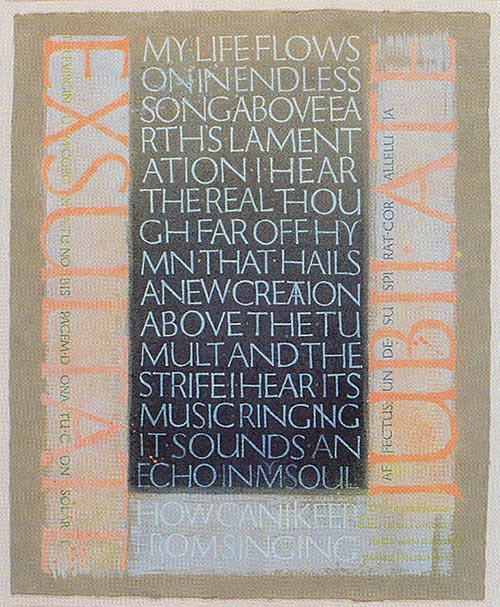
|
The words in the centre panel are the first verse of a Quaker hymn. The words of the Exsultate itself are not directly parallel but they are, I believe, complementary: Rejoise, shout, o ye blessed souls, singing sweet hymns; responding to your song the skies sing psalms with me. |
Les paroles au centre viennent de la première stroph d'un cantique quaker. Les paroles de l'Exsultate ne sont pas exactement parallèles mais complémentaires, à mon avis: Réjouissez, criez, Ô âmes bénies qui chantent d'hymnes joyeux, repondant a votre chant les cieux chantent des psaumes avec moi. |
![]()
COLOPHON BOOKARTS SUPPLY AB93 AWARD FOR PAPER DECORATION
Gillian Chipperfield | United Kingdom
1990 Decorated Paper/Papier décoré 54 x 43 cm
| Canson Ingres paper, moss size, gouache. | Papier Canson Ingres, carragheen, gouache. |
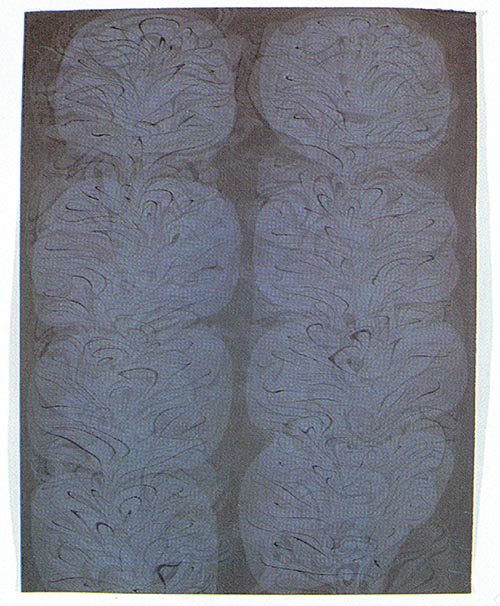
| My passion for marbling grew out of a desire to use it as an expressive element in my bindings which, in turn, led to making larger display pieces. I love to use traditional methods and materials in modern ways. I fight to keep books in all their aspects central to our culture. |
Ma passion pour la marbrure s'est développée à partir du désir de m'en servir d'élément expressif dans la reliure. Cela à son tour a mené à la fabrication de pièces d'exposition plus grandes. La combinaison de méthodes et de materiaux traditionnels et d'application modemes, me plait beaucoup. Je lutte pour l'existence du livre de toute sorte, comme element essientiel de notre culture. |
![]()
BOOKMAKERS INTERNATIONAL AB93 AWARD FOR FINE BINDING
Daniel E. Kelm | United States
A Space for Breathing1992 Fine Binding/Reliure d'art 80 x 70 x 5 cm
| Wire sewn binding developed by the binder, colour photographic transfers, and drawings by Shelagh Keeley. Assistance in the KeIrn Studio includes: Sarah Pringle, Indre Page, Carol Tyroller. | Pigûre à plat developpée par l'artiste, décalomanies photographiques, et dessins en couleur par Shelagh Keeley. Assistance à l'atelier Kelm: Sarah Pringle, Indre Page, Carol Tyroller. |
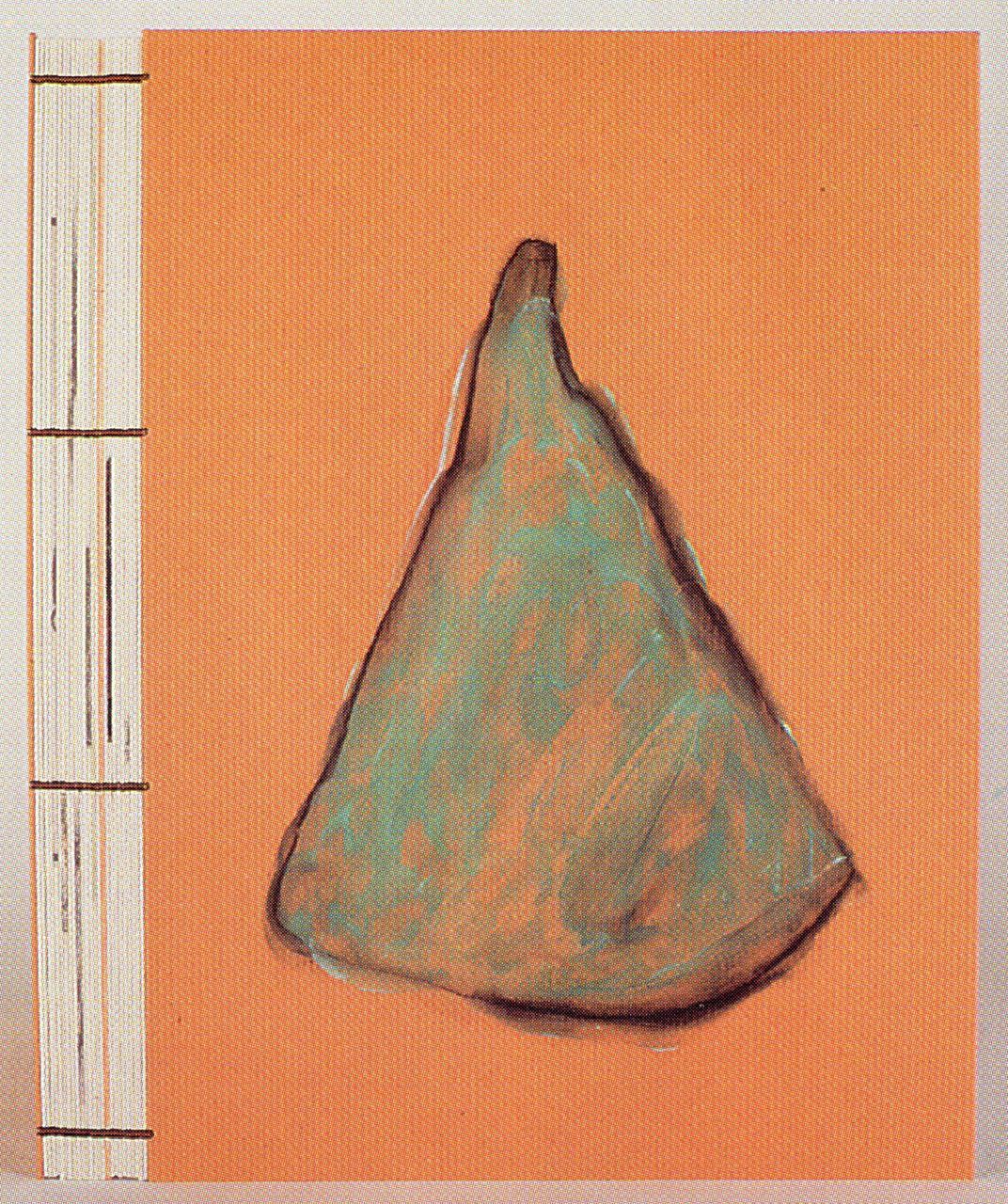
![]()
TALAS AB93 AWARD FOR FINE BINDING
Monique Lallier | United States
Menaud Maître-Draveur1992 Fine Binding/Reliure d'art 29 x 24 x 5.3 cm
| French technique binding, leather spine with decorative paper. | Reliure à la française, dos en cuir et papier décoré. |
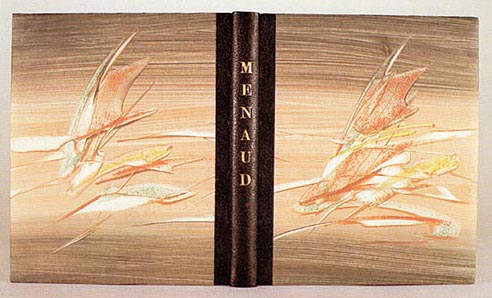
|
Bookbinding is an art of great beauty at the service of the book. It demands maturity and humility. After more than twenty years it is with the same pleasure and anxiety that I approach the book for which I am starting to think of the cover design. The paper, typography, text, and the illustrations first influence me in the conception of the design. The whole, as an "ensemble" must value the book and its message. My personal way of using the ancient technique of paste paper allows me to realize an original and affordable binding in harmony with the book and its value. I like to use the French technique of laced-in binding as a basic structure and treat it the English way for a good openability. It is with gratitude that I accept the award from CBBAG, and I am grateful for the encouragement this award provides me. |
La reliure est un Art d'une grand beauté, Elle demande de la maturité et de l'humilité. Apres plus de vingt ans, c'est toujours avac la même plaisir et la même anxiété que j'abord le livre pour lequel je m'aprête a créer un décor. L'ensemble doit mettre en valeur Ie livre et son message. L'interprétation personelle de l'ancienne te l'ancienne technique de papier a la colle, me permet de faire une reliure originale, abordable et en harmonie avec le contenu du livre et sa valeur. J'affectionne la technique française de passure en carton comme structure de base pour la reliure et je la traite a l'anglaise pour que le livre s'ouvre mieux. Cest avec gratitude que j'accepte ce prix et je remercie la Guilde Canadienne (CBBAG) pour Ie bel encouragement qu'il m'apporte. |
![]()
THE ART OF THE BOOK '93 AWARD FOR FINE PRINTING
Gordon Fluke | United States
J.D. Grahame Cracker Press
1990 Fine Printing/Typographie 27.9 x 37 x 1 cm
| Twenty broadsides printed letterpress, in handmade paper wrapper, collaboration with PWAs from across the United States. | Vingt placards, texte imprimé, jaquette de papier main, créés en collaboration avec des personnes atteintes du SIDA d'à travers les États-Unis. |
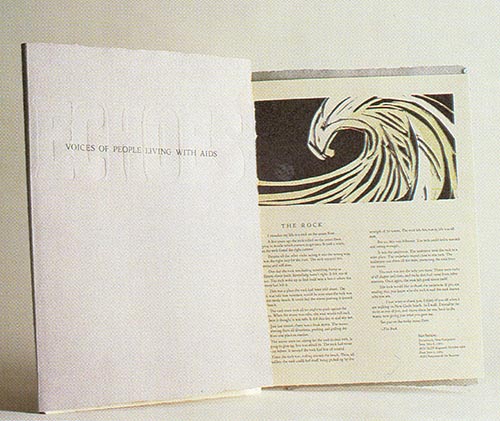
|
The world struggles to cope with a global epidemic that challenges our biases, our resources, and our ability to care for others. As the crises continues to spread and grow, we are confronted with numbers of infected people that increase geometrically and begin to lose meaning. Echoes was intended to allow people living with AIDS the opportunity to speak for themselves about their experiences. In this way, perhaps the disease could again be thought of in human terms. None of the work I have done prepared me for the emotional burden of inviting 16 people with AIDS into my life for several years. Some of the participants died during the production of the project and yet, I see the Echoes project as a celebration of life, and an affirmation of the basic goodness in people. |
CNous faisons de grands efforts pour affronter une éidémie globale qui met à l'épreuve nos préjugés, nos ressources, notre capacité de soigner les autres. Au fur et à mesure de la progression de cette épidémie, nous nous trouvons devant les personnes atteintes, un nombre qui augmente géométriquement et qui commence à perdre de signification. L'intention de Echoes etait de donner la parole aux personnes atteintes du SIDA afin qu'elles puissent elles-mêmes communiquer leurs expériences, d'humaniser un peu cette maladie. Je n'ai nullement été préparé à porter le fardeau émotionnel de partager ma vie avec 16 personnes atteintes du SIDA pendant ces quelques années. Quelques-unes sont mortes pendant la production de Echoes, je l'interprète quand même comme une celebration de la vie ainsi qu'une affirmation du bonheur essentiel des êtres humains. |
![]()
BOOKBINDER'S WAREHOUSE AB93 AWARD FOR FINE BINDING
Michael Wilcox | Canada
1992 Fine Binding/Reliure d'art 20.2 x 26.4 x 1.6 cm
| Chieftain goatskin, onlays, and gold tooling. | Chevre "Chieftain," mosaïques, et dorure à chaud. |
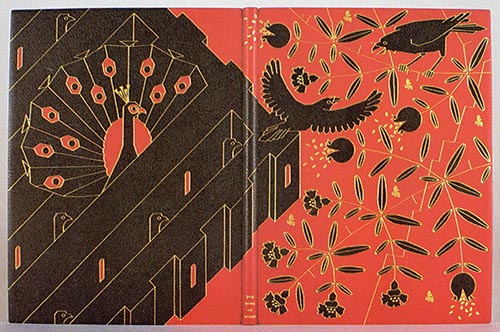
| Seven finishing tools were made especially for the creation of the binding design on this unusual version of the Song of Songs. I have, in my use of animal disguises, tried to play along with the author's need for caution in his condemnation of the King. Solomon's polygamous and foreign ideas are represented by the peacock – a bird that Solomon imported – while the common and monogamous ravens represent the two lovers who are true to their faith and true to the natural ways of the land. |
Set outils de finition ont été spéctatement créé pour la décor de cette reliure d'une version rare de Song of Songs. Me Servant d'animaux pour dequiser, j'ai tenté de refléter la caution qu'a dû exercer l'auteur dans sa condamnation du roi. Les idées polygames étrangères de Solomon sonts représentées par le paon que Solomon importé, et les corbeaux communs et monogames représentent les deux amants qui restent fidèles à leurs convictions et aux habitudes naturelles de la terre. |
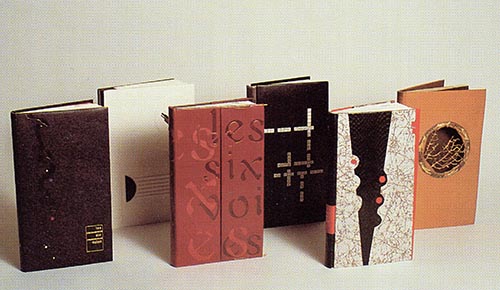
| Les Six Voies is a collaborative effort by six francophone women bookbinders, with various levels of experience, all living in Greater Montréal. The project was organised by Louise Genest. The title of the book means The Six Voices (or Ways) and the subtitle or theme is Les Mots (The Words). Each binder had one Signature to write and illustrate about the "Words"; any means of creativity was permitted as long as it was done by hand and could be reproduced faithfully so that each collaborator had her own copy to bind. | Les Six Voies est une collaboration collective de six femmes francophones, relieurs de niveau d'expérience variable, qui habitent la métropole de Montréal. Louise Genest a organisé le projet. Les Mots, le sous-titre du livre, est aussi le thème. À chaque artiste, on a alloqué un cahier, dans lequel elle ëcrivait et illustrait "Les Mots"; toute technique crïative a été acceptable pourvu que le travail soit effectué à la main et que la réproduction fidèle du cahier soit possible. Ensuite, les cahiers sont distribués aux artistes afin d'être relié. |
|
Lise Dubois | Canada Les Six Voies 25.5 x 17 x 2 cm Leather./Cuir. |
Christine Chartrand | Canada Les Six Voies 25.5 x 14 x 5.2 cm Leather and paper, simple Bradel binding./Cuir et papier, reliure Bradel simple. |

|
Simone Benôit Roy | Canada Les Six Voies 26 x 15 x 2 cm Fine binding./Reliure d'art. |
Denise Bellemare | Canada Les Six Voies 26.5 x 15 x 2 cm Box, fiberglass, paper, Bradel binding. / Boîte, fibre de verre, papier, reliure Bradel. |
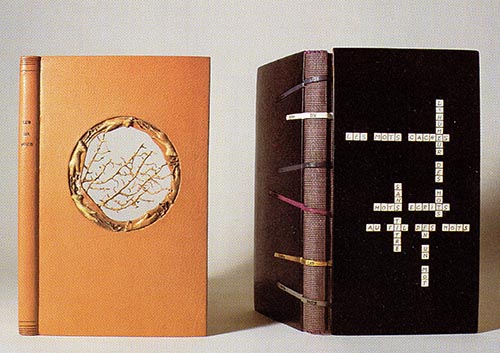
|
Louise Genest | Canada Les Six Voies 26 x 15 x 2 cm Leather, paper, laquer, inks. / Cuir, papier, laque, encres. |
Nicole Billard | Canada Les Six Voies 25.7 x 14 x 2 cm Fine binding./Reliure d'art. |
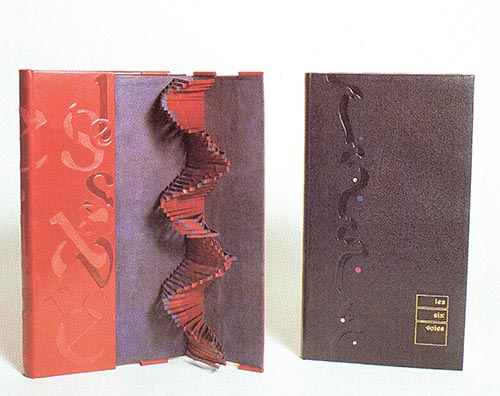
|
Denise Bellemare My fascination for the art of bookbinding stems namely from my love of books. I take great pride and pleasure in giving shape to an author's words and spirit, while adding my own personal vision of his or her work. With Les Six Voies, my colleagues and I had the opportunity to act as both authors and bookbinders, drawing from each other's talent, imagination, and creativity. This collaboration was altogether a highly enjoyable and fulfilling experience. |
Ce qui m'attire avant tout vers l'art de la reliure, c'est la passion des livres. C'est aussi le plaisir de traduire de façon visuelle l'esprit et l'essence d'une oeuvre, tout en y ajoutant ma vision personnelle. Les Six Voies est la fruit de l'imagination et du talent de notre groupe de relieures. Ce collectif nous a permis à la fois d'écrire et de relier un livre en tenant compte de la créativiteéde chacune d'entre nous. Cette expérience des plus enrichissantes m'a apporté une grande satisfaction professionnelle. |
|
Nicole Billard A series of asymmetric parallels meandering over the pages, Les Six Voies allowed a bookbinder to wrap her own thought, using traditional techniques while projecting a contemporary design. My binding tries to procure as much a tactile as a visual pleasure. The meandering way "Vole" embossed on the covers, leads your finger tips through the different textures of the fine grained leather, polished, around onlays of dots. The binding should protect and preserve the book. Furthermore, the binding should be a significant extension of the creative illustrated and written content. |
Une série de parallèles assymétriques sillonnent les pages. Les Six Voies a permis au relieur d'habiller ses pensées, utilisant des techniques traditionelles tout en projetant un design contemporain. Sa reliure cherche à apporter une sensation autant tactile que visuelle. Les sillons (Voies) courant sur les plats laissent vos doigts découvrir les differentes textures d'un chagrin, d'un cuir poli, et des mosaïques. La reliure se doit de protéger et conserver le livre. De plus, la reliure devient Ie prolongement de l'écrit et des illustrations. |
|
Christine Chartrand Leather and paper are fascinating things which could offer so many possibilities into our project. Concerning this achievement, I preferred the use of an imaginative alphabet to a written statement. This alphabet was created and made from leather and paper. I also combined a few characters with the same structure into this form of statement. The way that the bookbinding is done you can easily see the arrangement with the character as well as the imaginary alphabet. |
|
|
Lise Dubois The creation of Les Six Voies took place over several years. The project turned out to be a very stimulating experience because of the challenge it presented for each one of us. Although we realized that it was a daring undertaking, the project's completion was proof of our persistence that had been nurtured by the friendship and support required for this type of creative venture by a group. In view of the different approach taken by each of us, I chose a stark black-and-white binding that focussed on the contrast of forms rather than on the content of the book. I did not want to include more colour since a single decorative element sufficed to mirror the tones used in my signature. Although the creative process was difficult and painstaking at times, the project was fascinating – an experience I would gladly repeat. |
La réalisation des Les Six Voies, qui s'est échelonnée sur quelques années, s'est avérée une expérience de plus stimulantes à cause du défi qu'elle représentait pour chacune d'entre nous. Conscientes de l'audace du projet, son aboutissement a été le fruit de notre ténacité nourrie par une amitié, un soutien et une complicité nécessaires à ce type d'aventure creatrice collective. Devant la diversité du travail de chacune, j'ai opté pour une reliure dépouillée en noir et blanc faite surtout de contrast dans les formes et qui n'avait aucun rapport avec Ie contenu du livre. Je n'ai pas voulu faire intervenir d'avantage la couleur; seul unélément décoratif reprend les tons utilisés dans mon cahier. Bien que le chemin parcouru tout au long du processus de création ait été parfois difficile et laborieux, l'experience fut passionnante et m'a donné le goût de la renouveler. |
|
Louise Genest In this project I tried a creative approach to the word: my section dealt with other aspects than the meaning or text. I decided upon three characteristics: the graphics as a unity of time and space, grammar as an organizer of thoughts, and calligraphy as a mastering of fine motor-eye coordination. The binding conveyed the same approach: the title became the design and, hidden under flaps, a representation of my own section – a 3-D onlay. I chose boxcalf, a temperamental leather that responds beautifully to embossing. Technically this was the most difficult binding I ever did. |
Dans ce projet, "les Mots" sont abordés de façon créative, sois hors du contexte littéraire. Mon cahier est élaboré sur trois aspects: les charactères comme unité de temps et d'espace, la grammaire comme organisatrice de la pensée et la calligraphie comme fruit d'une maturation de la coordination oculo-motrice. La reliure a été elaboree dans ce même esprit. Le titre est le décor et, caché sous les rabats des plats, un élément de mon cahier soit une mosaïque en trois-dimensions. J'ai choisi la peau de Box. Quoique capricieuse, elle se prête admirablement au relief. Techniquement, cette reliure fut la plus difficile à réaliser. |
|
Simone Benoît Roy It is no doubt unusual for six professional bookbinders to join in creating a book. As part of my personal contribution I wanted, through my design, to emphasize this unique experience. The six hands are joined by small threads representing our cooperation. The circle and its inner sinuosities symbolize our different ways to express it. |
C'est sans doute inhabituel, cette collaboration entre six relieurs professionnelles pour créer un livre. Comme partie de ma contribution person nelle, j'ai voulu par l'entremise du décor, souligner cette experience unique. Les six mains sont liées par de petits fils qui représentent notre co-opération. Le cercle et ses sinuosités intïrieures symbolisent les modes d'expressions différentes. |
Jocelyne Aird-Bélanger | Canada
Rituels D'Ameriques
1990 Artists' Books/Livre d'artiste 44 x 33 cm
| Eleven prints by the artist, poems by Jean-Paul Daoust. | Onze estampes par l'artiste, poèmes de Jean-Paul Daoust. |
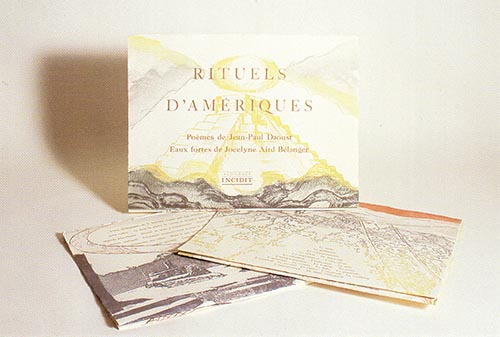
![]()
Anna Banana | Canada
20 Years of Fooling Around with A. Banana
1990 Artists' Books/Livre d'artiste 7.1 x 7 cm
| Mini book with 20 full colour stamps, tipped over black and white illustrations, from 20 years in the Bananalogical activities of Ms A. Banana. | Livre miniature contenant 20 estampes colorées colées à plat sur des illustrations blanches et noires, de vingt années d'activités "Bananalogiques" de Ms A. Banana. |

![]()
Reg Beatty | Canada
Notation
1992 Artists' Books/Livre d'artiste 24 x 16 x 5 cm
| Murasaki, Araishu, St.-Armand Papers, silk thread, ink. | Murasaki, Araishu, papiers St.-Armand, fil de soie, enere. |
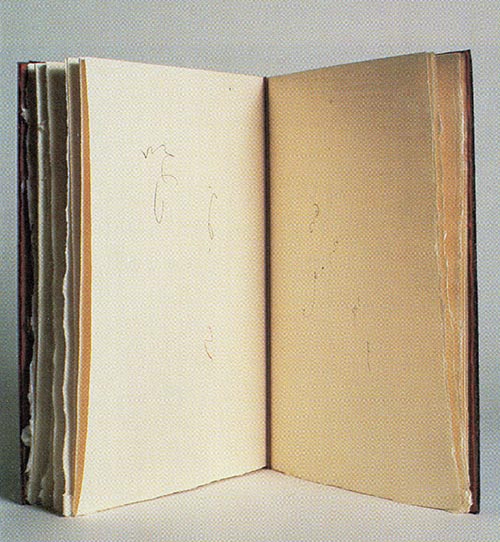
![]()
|
Jane Conneen | United States The Little Farm Press The Winding Roads of Ireland 1990 Artists' Books/Livre d'artiste 5 x 6 cm Printed on etching press on Richard de Bas Canton, coloured pencil, cloth binding./Imprimé sur une presse de gravure, papier Richard de Bas Canton, crayon de couleur, reliure en tissu |
The Language of Herbs I & The Language of Herbs II 1990-1991 Artists' Books/ Livre d'artiste 4.4 x 4.1 cm Printed by Gocco on Hahnemühle Ingres, coloured pencil, bound in moss green Ingres./Imprimé par “Gocco” sur du Hahnemühle Ingres, crayon de couleur, relié en Ingres vert mousse. |
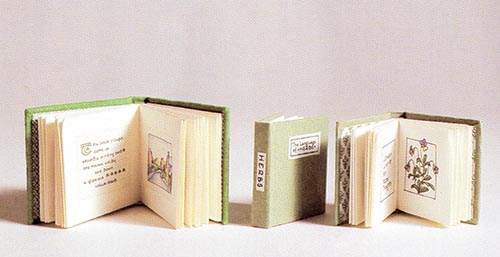
![]()
Anne-Claude Cotty | Canada
Finish Line
1992 Artists' Books/Livre d'artiste 23 x 13 x 4 cm
| Pop-ups, screen prints. | Livre animé, sérigraphie. |
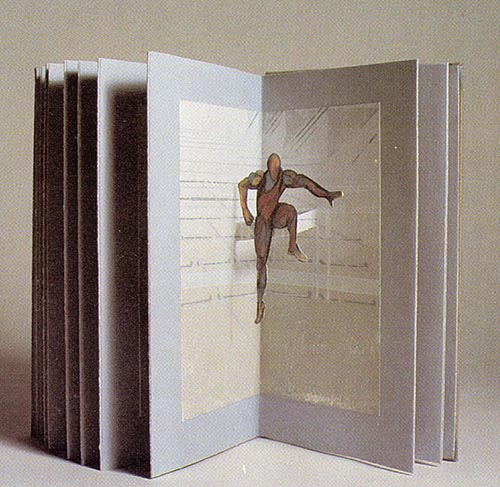
![]()
Patricia Gabriel | United States
His and Hers
1992 Artists' Books / Livre d'artiste 20 x 15 x 5 cm
| Wallpaper, copied image, text. | Papier peint, image copiée, texte |

![]()
Whatta Pie
1991 Artists' Books/Livre d'artiste 11 x 13 cm
| A dozen pie related legends, rumours, and quotations on wedge shaped pages which fan out, fold out, unfold, rotate, and flip over. |
Une douzaine de légendes, rumeurs, et citations au sujet des tartes, morceaux de papier qui s'étalent, s'ouvrent, se tournent, et qui pouvent être feuilletés. |
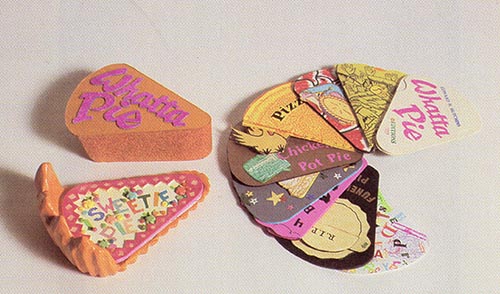
![]()
Jorg Jakoby | United States
Die Sense
1990 Artists' Books/Livre d'artiste 18.5 x 22 cm
| Paper, silk-screened. | Papier, sérigraphie. |
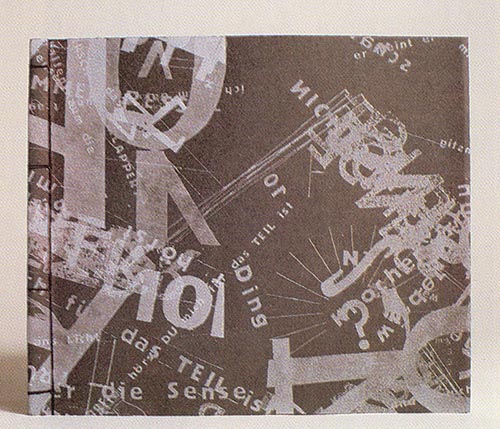
![]()
Karen Kunc | United States
"0&"
1991 Artists' Books/Livre d'artiste 16.5 x 17.3 x .5 cm
| Shaped paper with woodcut relief and intaglio image, four folded sections. | Papier taillé, décor de gravure sur bois en relief et intaillé, quatres cahiers pliés. |
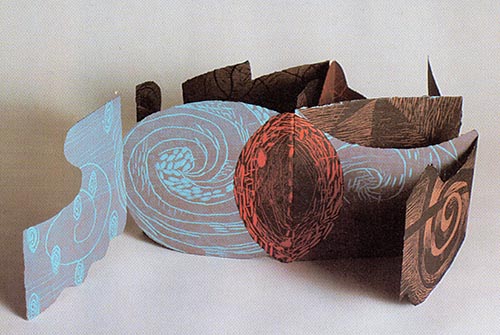
Karen Kunc | United States
Agri Culture
1992 Artists' Books/Livre d'artiste 38.1 x 6.5 x 4 cm
| Eighteen pages of carved and painted cherrywood, sewn binding. |
Dix-huit pages de bois de cerisier, taillé et peint, reliure à couture. |
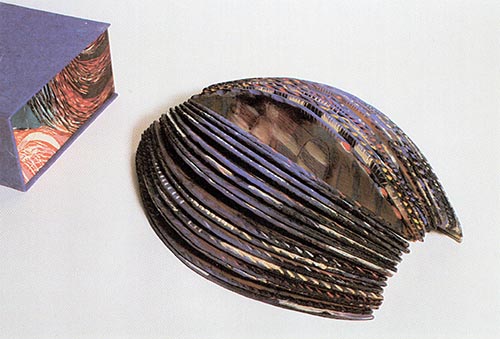
David LaPlantz | United States
Artist's Book #1
Artists' Books/Livre d'artiste 17 x 18 x .91 cm
| Fabricated painted aluminum, colored paper, rubber etc. | Aluminium peint, papier coloré, caoutchouc, etc. |
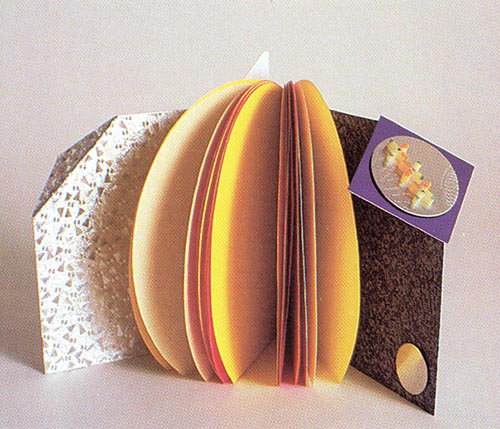
Françoise Lavoie | Canada
Hôtel
Artists' Books/ Livre d'artiste 91. 5 x 61 x 16 cm
| Six engravings in sculptural box. | Six gravures en boîtes sculptée. |
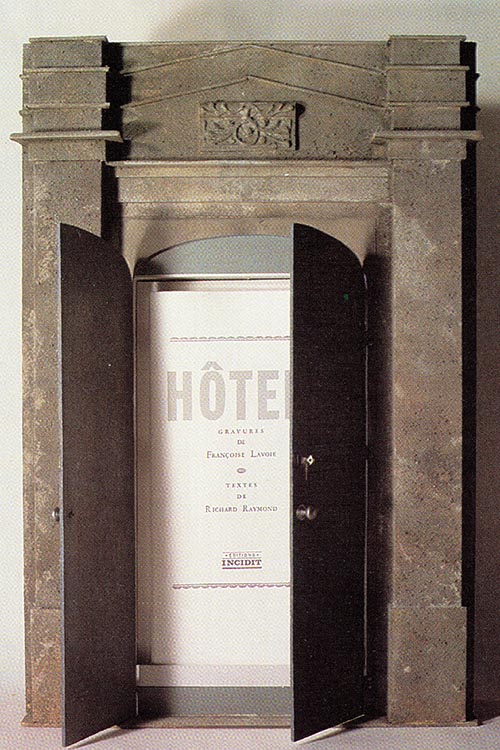
Nicole Malenfant | Canada
Intarsia
1990 Artists' Books/ Livre d'artiste 58.5 x 45 x 2 cm
| Ten original prints in intaglio lithography, serigraphy, and photography, using handmade paper and handmade box. | Dix estampés originales, lithographiées, sërigraphiées, et photographiées, papier et boîte faits à la main. |
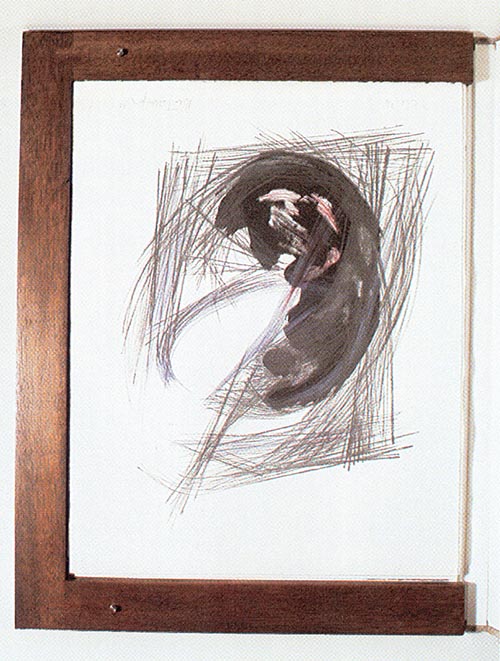
Judy Martin | Canada
Don't Go Crazy
1992 Artists' Books/ Livre d'artiste 24 x 26 x 4 cm
| A soft cloth and paper book, drawings, and pressed leaves applied. | Reliure souple de tissu et de papier, décor de dessins, et feuilles aplaties. |

Judy Martin | Canada
Red Book
1990 Artists' Books/ Livre d'artiste 30 x 30 x 5 cm
| A soft cloth and paper book exploring the colour red. | Reliure souple de toile et de papier, exploration de la couleur rouge. |
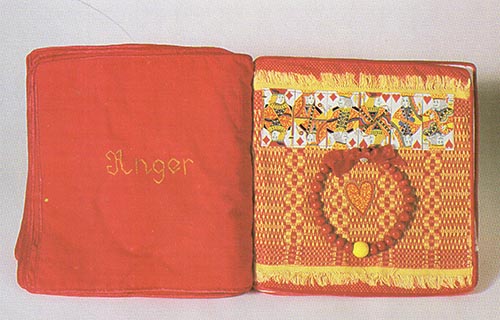
Susan Meier | United States
Penumbrae
1992 Artists' Books/ Livre d'artiste 28.2 x 31 x 41 cm
| Accordian binding, pulp painting on handmade paper. | Reliure accordéon, peinture de pulpe sur papier main. |
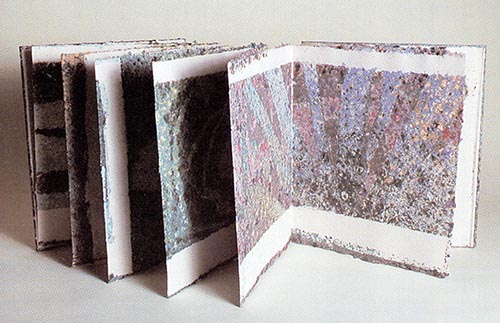
Lise Melhorn-Boe | Canada
Sex Lives of Vegetables
1991 Artists' Books/ Livre d'artiste 27 x 16.5 x 2.3 cm
| Colour photocopied vegetables and text laminated to handmade paper in handmade paper case. | Legumes et texte xérographiés en couleur et larnines aux feuilles de papier main, couverture de papier main. |
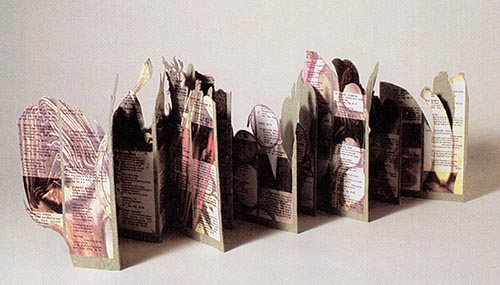
Claire Owen | United States
Of Fur and Flesh
1991 Artists' Books/ Livre d'artiste 19.4 x 20 x 4 cm
| Limited edition woodcuts and lino cuts, Japanese binding. | Édition limitée de gravures sur bois et linoléum, reliure japonaise. |

|
Mary Jo Pauly | United States Typographic Topiary I 1990 Artists' Books/ Livres d'artist 13.5 x 12 x 5 cm Sculptural book with pop-ups./ Livre animé sculptural |
Typographic Topiary II 1990 Artists' Books/ Livres d'artist 13.5 x 12 x 5 cm Mixed Media – paper (handmade, cast) gouache, co loured pencil./ Media divers – papier (main, moulé), gouache, crayon de couleur. |
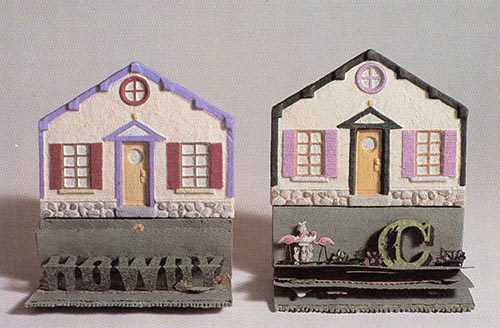
Sarah Peter | United States
Holding It Together
1992 Artists' Books/ Livre d'artiste 10.2 x 10 x 2 cm
| Accordian book of silverpoint drawings bound in vellum. | Reliure d'accordéon en vélin, gravures à la pointe d'argent. |

Leslie A. Puckett | United States
Moonscape
Artists' Books/ Livre d'artiste 25.4 x 30 x 5 cm

Miriam Shenitzer | Canada
How To Talk About Art
1991 Artists' Books/ Livre d'artiste 21.5 x 24 x 2 cm
| Satirical pop-up book. | Livre animé satirique. |
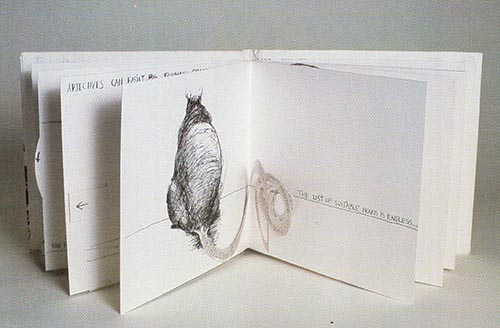
Peter Sramek | Canada
What Angels Think
1992 Artists' Books/ Livre d'artiste 9 x 9 cm
| Computer printed image, Oasis leather with photocopy transfer. | Image produite par l'ordinateur, cuir oasis, décalomanie xérographié. |
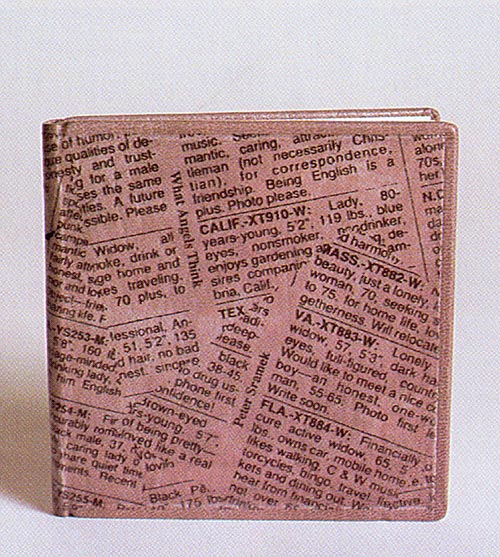
![]()
Don Taylor | Canada
Tlön, Uqbar, Orbis Tertius
1992 Artists' Books/ Livre d'artiste 27 x 18 x 3 cm
| Each copy has a different combination of stick-on vinyl letters. Binding by Anne Sutherland. |
Chaque copie porte une combinaison de lettres de vinyle adhésif. Relie par Anne Sutherland. |
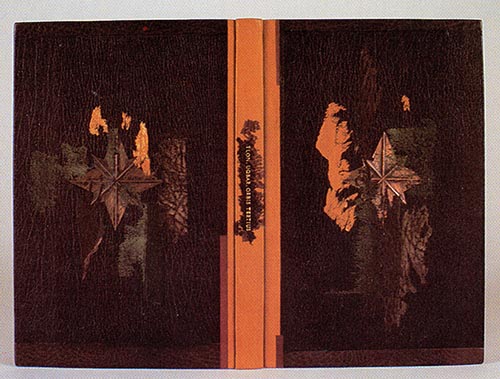
![]()
Claire Van Vliet | United States
Narcissus
1990 Artists' Books/ Livre d'artiste 35.8 x 50 x .3 cm
| Boxed, book wall with colour laser images. | Une oeuvre murale de livres, images de "laser" en couleur, boîte. |
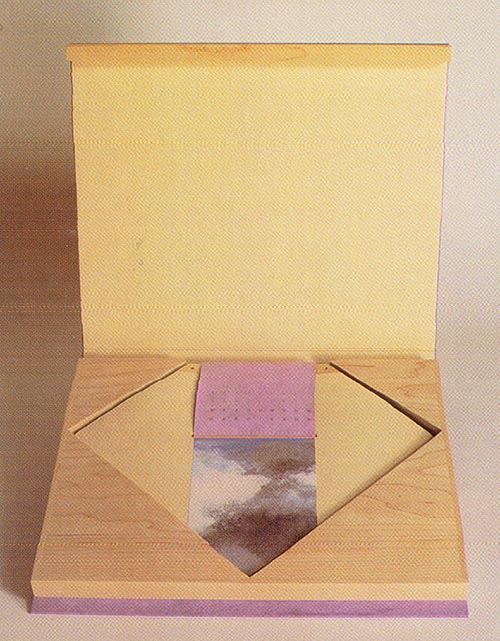
![]()
George Walker | Canada
Acrophony (Symbol & Sound)
1991 Artists' Books/ Livre d'artiste 32 x 32 cm
| CD and handpainted book in box. | Disque compact et livre peint à la main, boîte. |

|
Jody Williams | United States loitering wild life (#6/77) 1992 Artists' Books/ Livres d'artiste 7 x 5.5 x 2 cm Accordian book, handmade paper, etching, letterpress./ Reliure accordéon, papier main, gravure, texte imprimé. |
time will tell (#28/52) 1991 Artists' Books/ Livres d'artiste 5.3 x 8.5 x 1 cm Accordian book, handmade paper, etching, letterpress./ Reliure accordéon, papier main, gravure, texte imprimé. |

Pamela Barlow Brooks | Canada
Art begins with craft
1992 Calligraphy/Calligraphie 90 x 150 cm
| Ink, paint, crayon on Nepalese paper and unbleached cotton. | Encre, peinture, pastel, sur du papier de Népal et du coton naturel. |
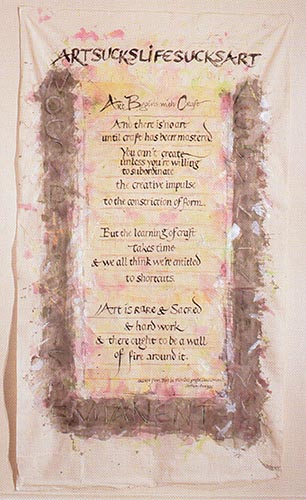
![]()
Margaret Challenger | Canada
A Box of Words
1992 Calligraphy/Calligraphie
| Small paste paper-covered box, containing cards and calligraphy | Petite boîte couverte de papier à la colle, con tenant des cartes calligraphiées. |

Lorraine Douglas | Canada
The Stolen Branch
1991 Calligraphy/Calligraphie 42.4 x 49 cm
| Poem by Pablo Neruda. Watereolours. | Poème de Pablo Neruda. Aquarelles. |
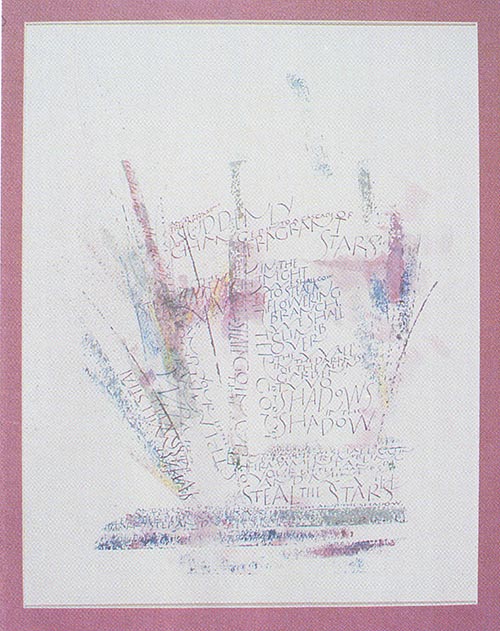
![]()
Nancy Ruth Jackson | Canada
House Blessing
1991 Calligraphy/Calligraphie 43 x 50 cm
| Painted inscription in gouache. | Inscription illuminée en gouache. |
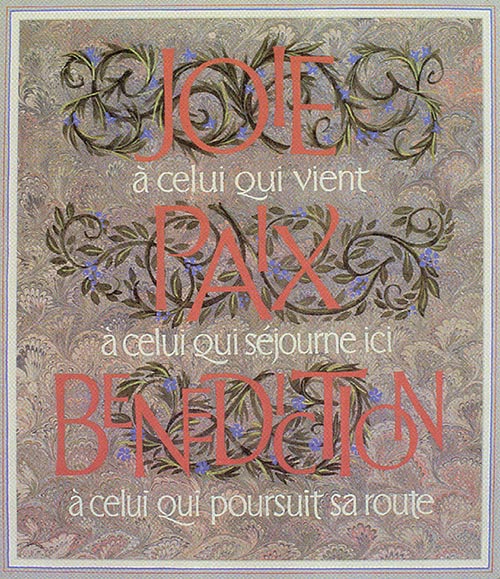
![]()
Lindley McDougall | Canada
A Vision
1992 Calligraphy/Calligraphie 38 x 52 cm
| Rotring acrylic ink, white gouache. | Encre acrylique Rotring, gouache blanche. |
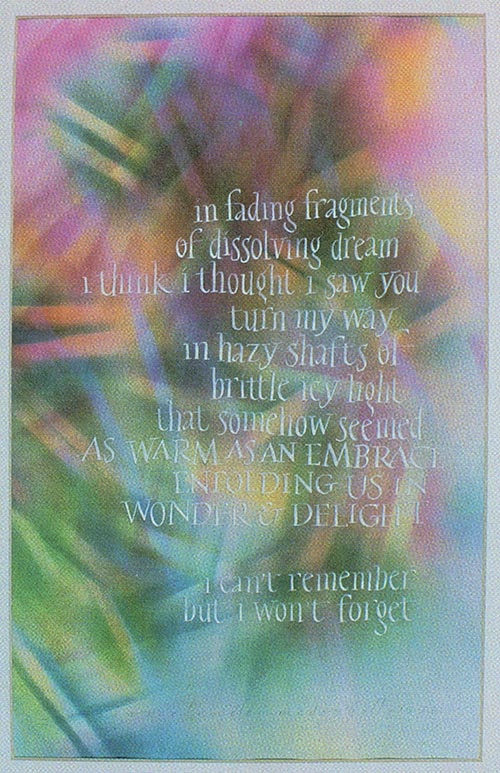
![]()
Lindley McDougall | Canada
Qui Sua Esse Potest
1992 Calligraphy/Calligraphie 49 x 38 cm
| Pencil crayon, ink, xerography. | Crayon de couleur, encre, xérographic. |
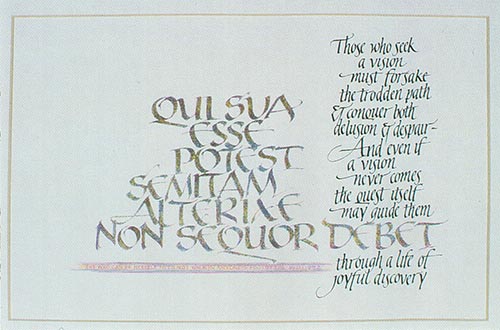
![]()
Susan van Tijn | Canada
The Congo
1992 Calligraphy/Calligraphie 7 x 12 cm
| Marbled and Canson paper, gold thread. | Papier marbré et Canson, fil d'or. |
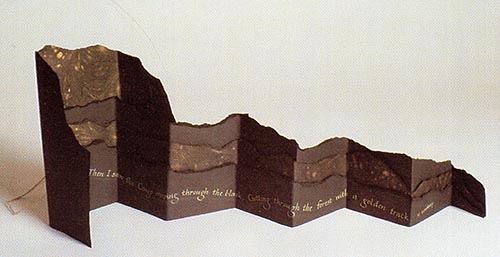
Gretchen Weber | United States
Weeds
1990 Calligraphy/Calligraphie 220 x 85 cm
| Japanese and handmade papers, silk thread, gouache. | Papiers japonais et faits à la main, fil de soie, gouache. |

Anick Butré | France
La Rose
1992 Decorated Paper/ Papier décoré 65 x 43 cm
| Paper. |
Papier. |
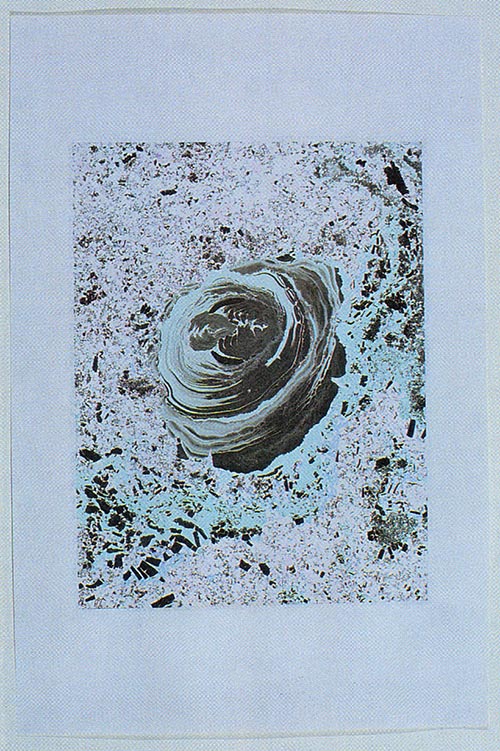
![]()
Janet F. Carroll | Canada
Stamps For New Nations
1992 Decorated Paper/ Papier décoré 4 x 5.7 x 5.1 cm
| Marbled stamps in nine miniature concertina books, in balsa crate. | Neuf livres miniatures, reliures accordéons, con tenant des estampes rnarbrées, boîte de balsa. |
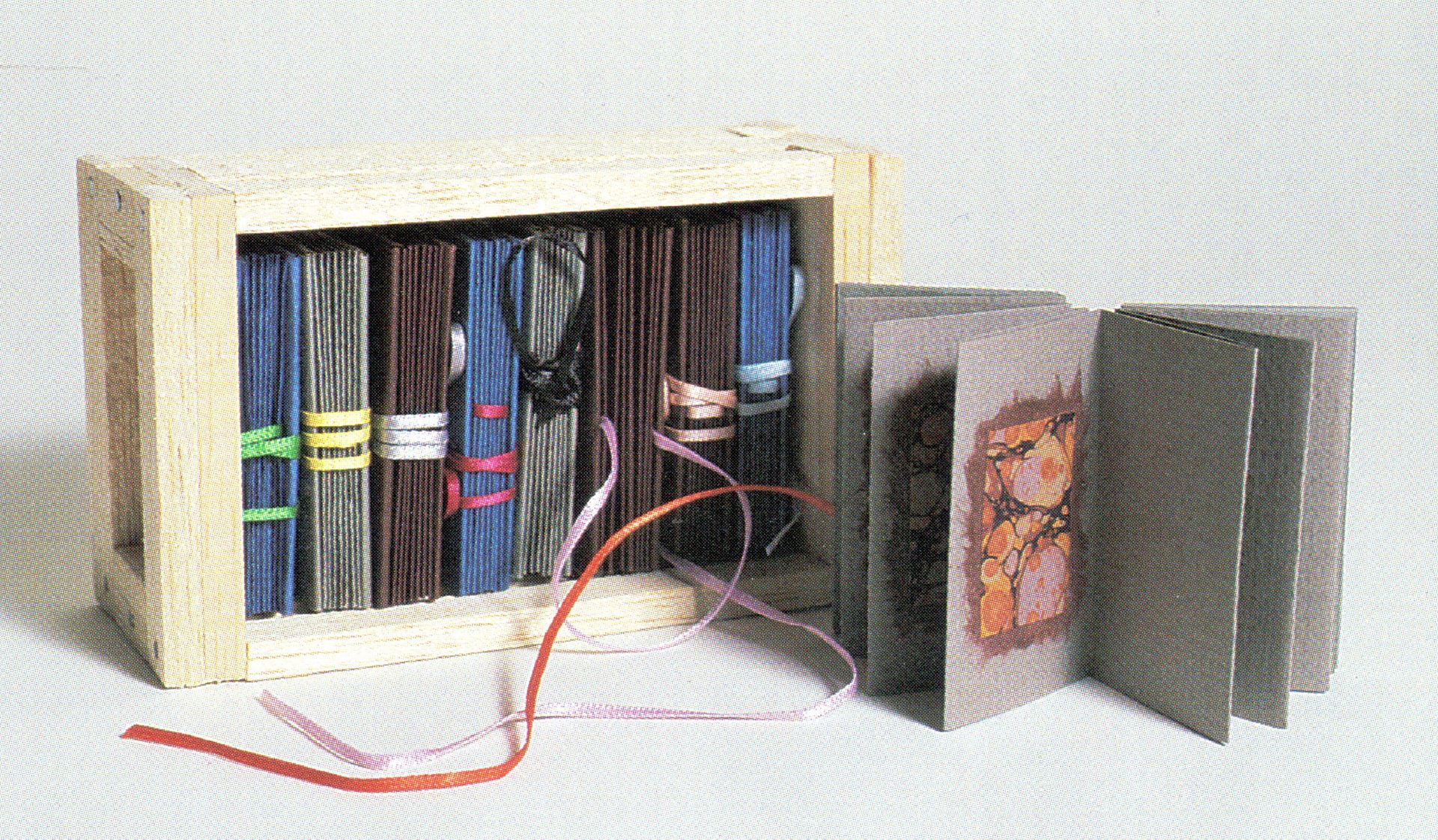
![]()
Gillian Chipperfield | United Kingdom
Grey Flowers
1990 Decorated Paper/ Papier décoré 30.5 x 40 cm
| Japanese paper, guar gum size, Chinese stick ink. | Papier japonais, gomme guar, encre chinois. |
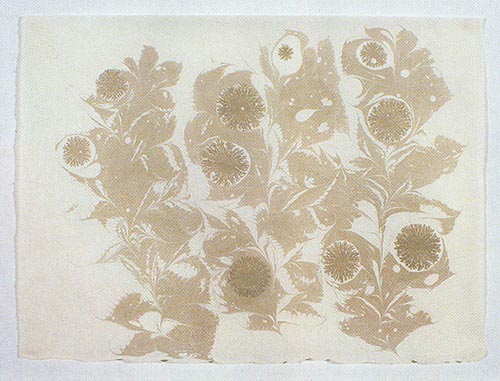
![]()
Polly Fox | United States
Previously Uncharted Territory
1991 Decorated Paper/ Papier décoré 42 x 56 cm

![]()
Polly Fox | United States
New Mexican Flower
1992 Decorated Paper/ Papier décoré 37 x 28 cm
| Part of a series of marbled papers of large flowers. | Partie d'une série de papiers marbrés illustrant des gran des fleurs. |
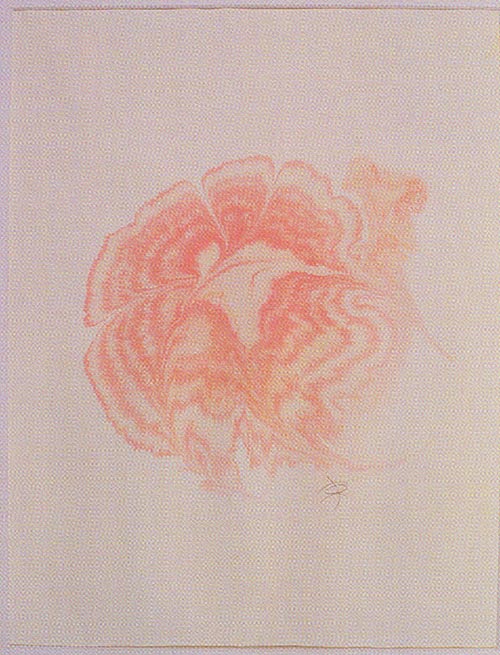
![]()
John Hyltoft | United States
Spider Web
1991 Decorated Paper/ Papier décoré 28.5 x 36 cm
| Hand decorated paper, paste marble technique. | Papier décoré main, technique de marbrure ancienne. |

Monique Lallier | United States
Marbled Paper
Decorated Paper/ Papier décoré 54 x 44 cm
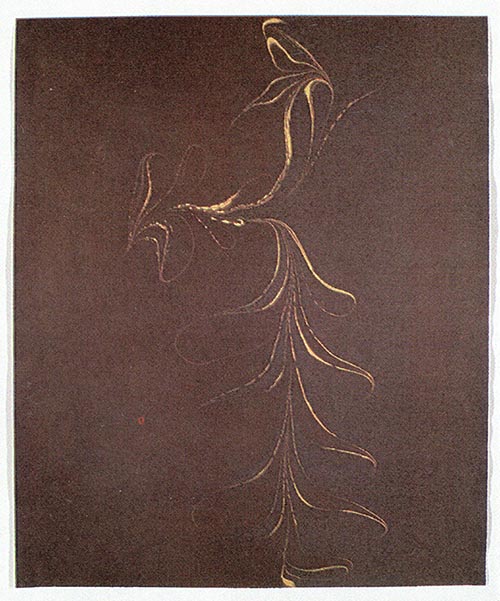
Margaret Sahlstrand | United States
Plum
1992 Decorated Paper/ Papier décoré 57.5 x 76 cm
| Embossed intaglio paper with graphite and gold leaf. | Papier intaillé et gaufré de graphite et de l'or en feuille. |
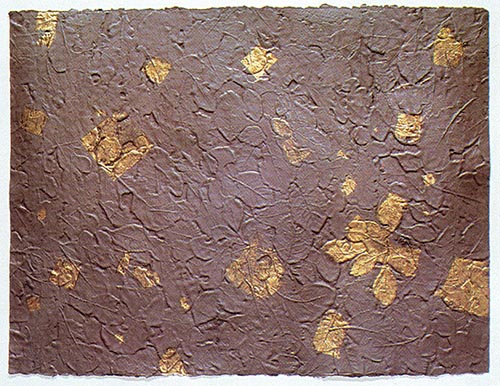
Eva van Breugel | Netherlands
Combed Undulated Marbled Paper
1992 Decorated Paper/ Papier décoré 55 x 75 cm
| Watercolours - carragheen. |
Aquarelles - carragheen. |
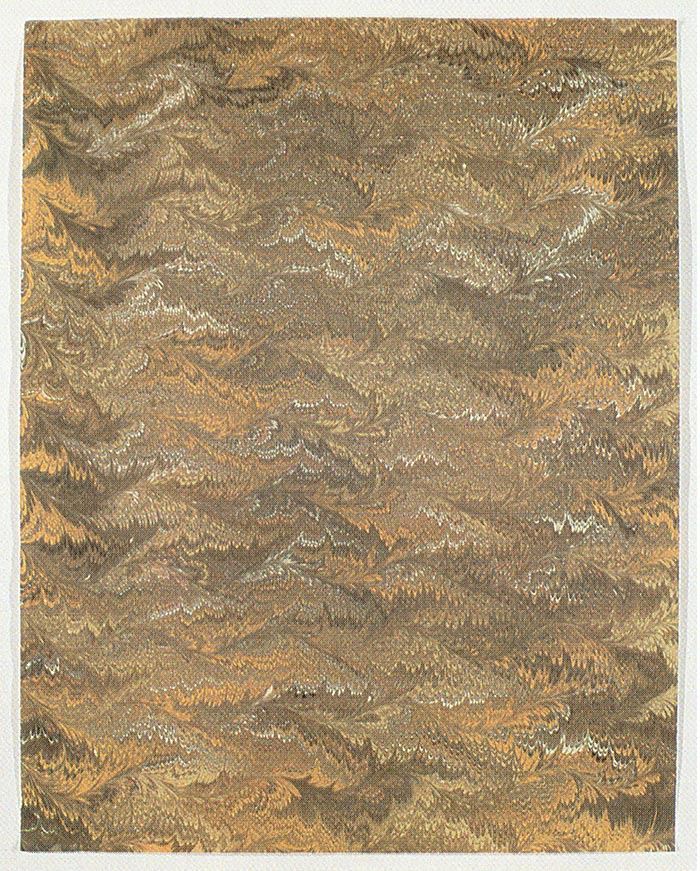
Eva van Breugel | Netherlands
Tiger Eye Flowers
1992 Decorated Paper/ Papier décoré 39.5 x 52 cm
| Watercolours - carragheen. |
Aquarelles - carragheen. |
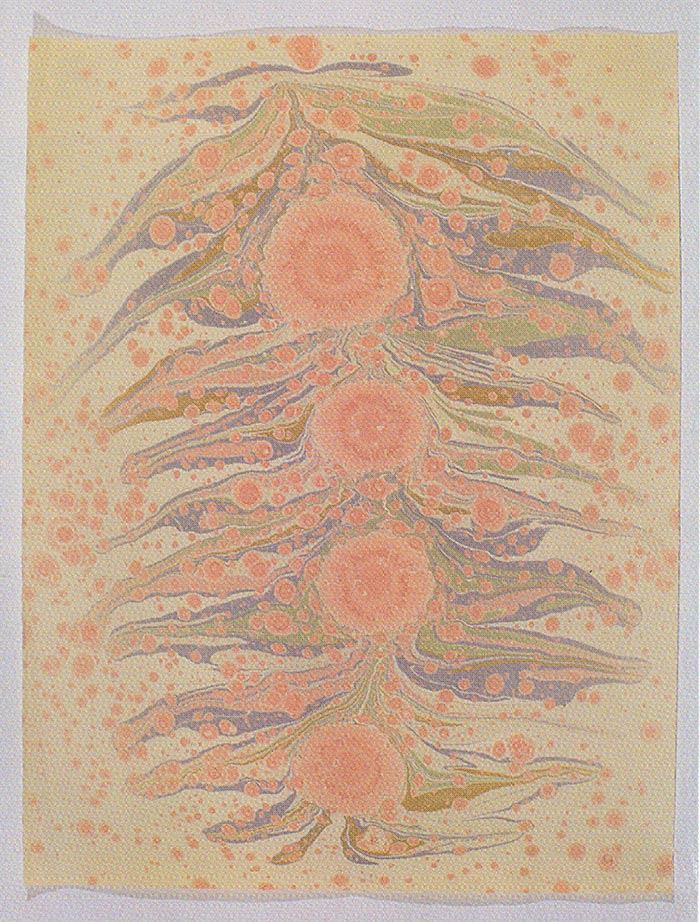
Angela Bogle | England
The Compleat Angler
1992 Fine Binding/ Reliure d'art 23.3 x 16 x 3 cm
| Full calf. |
Plein veau. |
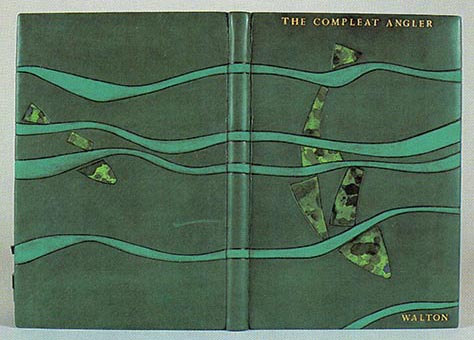
![]()
Bert J. Borch | Canada
Non-Adhesive Blank Book
1992 Fine Binding/ Reliure d'art 26 x 16 x 3 cm
| Cover: Fabriano Roma paper, paste paper by binder; text: teton archival paper, sewn longstitch with dyed linen thread. | Couverture: papier Fabriano Roma, papier à la colle par l'artiste: corps d'ouvrage: papier permanent "teton", couture aux points longs avec du lin tienté. |
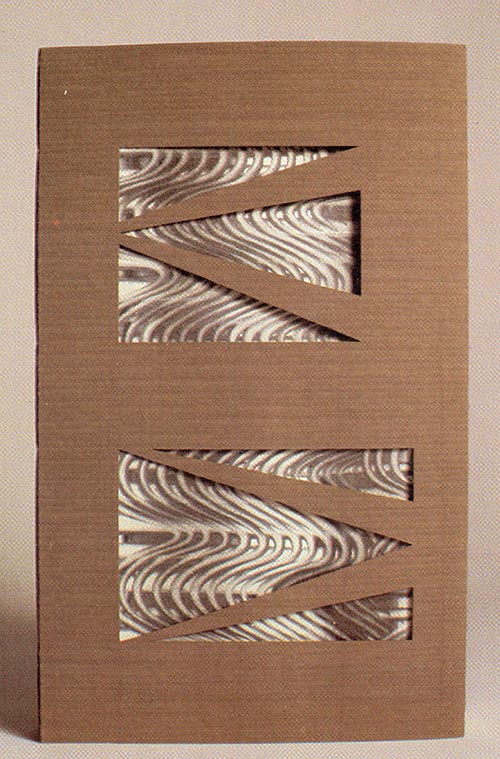
![]()
Old Ream Wrappers
1991 Fine Binding/ Reliure d'art 24 x 19 x 2 cm
| Half leather, blue Oasis, and Arches paper, block printed cover papers. |
CDemi cuir, oasis bleu et papier Arches, papier de couverture estampé. |
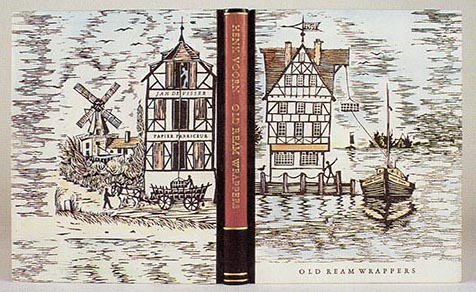
![]()
Fritz Eberhardt | United States
Bible Texts
1992 Fine Binding/ Reliure d'art 23 x 21 x 2 cm
| Dark blue leather and marbled paper, gold tooling. | Cuir bleu foncé et papier marbré, décor à l'or. |

![]()
![]()
Cheryl Mazurek | Canada
Drawing Album
1992 Fine Binding/ Reliure d'art 31.2 x 25 x 1 cm
| Japanese binding. |
Reliure japonaise. |
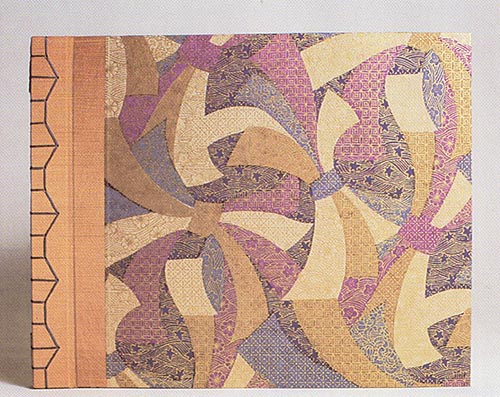
![]()
Priscilla A. Spitler | United States
Morandi's Bottles
1992 Fine Binding/ Reliure d'art 26.8 x 20 x 5.5 cm
| Quarter French hard-grain Morrocco, plexiglas boards underpainted. | CDemi reliure en chagrin français, plats en plexiglass peints sur le côté antérieur. |

Guy Davenport | United States
Anakreon: The Extent Fragments
Fine Printing/ Typographie 28.5 x 1 x 5 cm
| Printed letterpress, Roma handmade paper and papyrus, paper birch bark fragment on cover, papyrus flyleaf. | Texte imprimé, papier Roma et papyrus, fragment de bois de bouleau sur la couverture, garde de papyrus. |
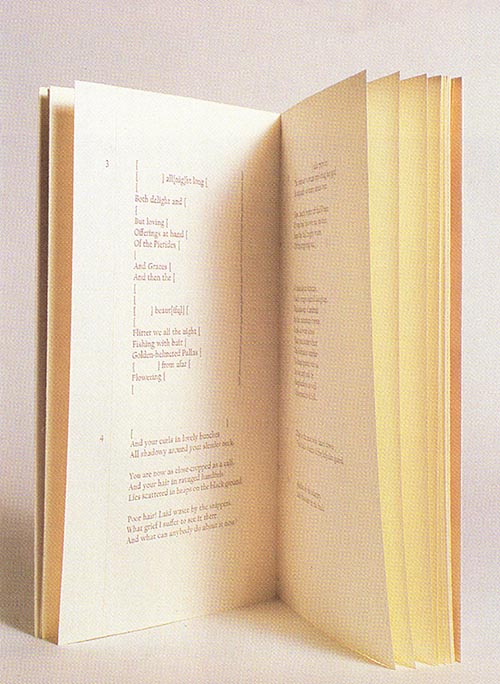
![]()
Michael Dobson | Canada
Pale Ports of Amber
1991 Fine Printing/ Typographie 37.8 x 27 x 7 cm
| Rives BFK. | BFK de Rives. |

![]()
Fiona Garrick | Canada
Mr. Bear's Song
1992 Fine Printing/ Typographie 21 x 25 x 2 cm
| Printed letterpress, hot metal type, written, designed, illustrated, printed and bound by author. | Typographie, charactères métalliques, oeuvre écrite, désignée, illustrée, imprimée, reliée par l'artiste. |
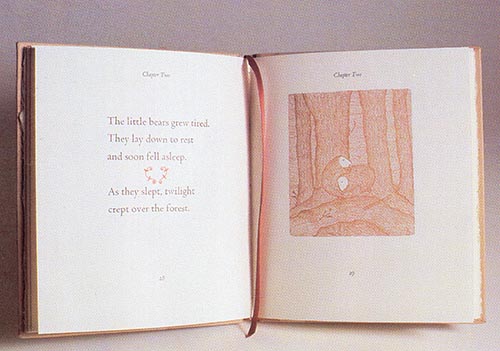
![]()
Margaret Lock | Canada
Know Thyself
1992 Fine Printing/ Typographie 19.5 x 26 x 1.2 cm

![]()
John L. Risseeuw | United States
The Bill of Rights
1991 Fine Printing/ Typographie 41.3 x 52 cm
| Five colour letterpress broadside on paper handmade from American flags. | Placard imprimé en cinq couleurs, papier fait de drapeaux des États-Unis. |
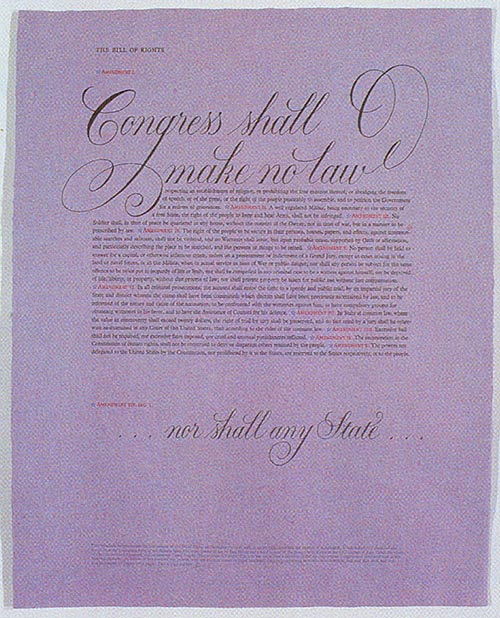
![]()
William Rueter | Canada
Distant Tones
1990 Fine Printing/ Typographie 15.5 x 15 x 5 cm
| Paper, batik, leather. |
Papier, batik, euir. |
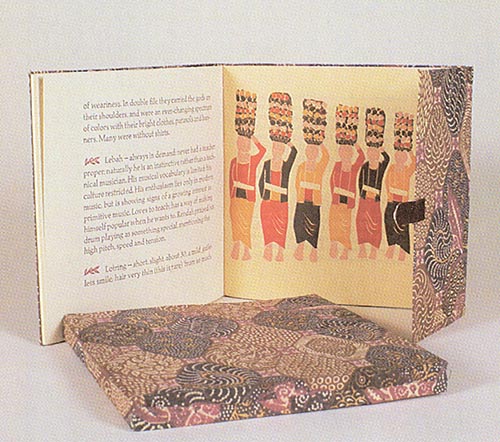
![]()
William Rueter | Canada
Great Nations
1991 Fine Printing/ Typographie 48 x 24 cm
| Paper, type. |
Paper, typographie. |

William Rueter | Canada
Shaking The Peonies
1992 Fine Printing/ Typographie 62 x 25 cm
| Paper, type. |
Papier, typographie. |
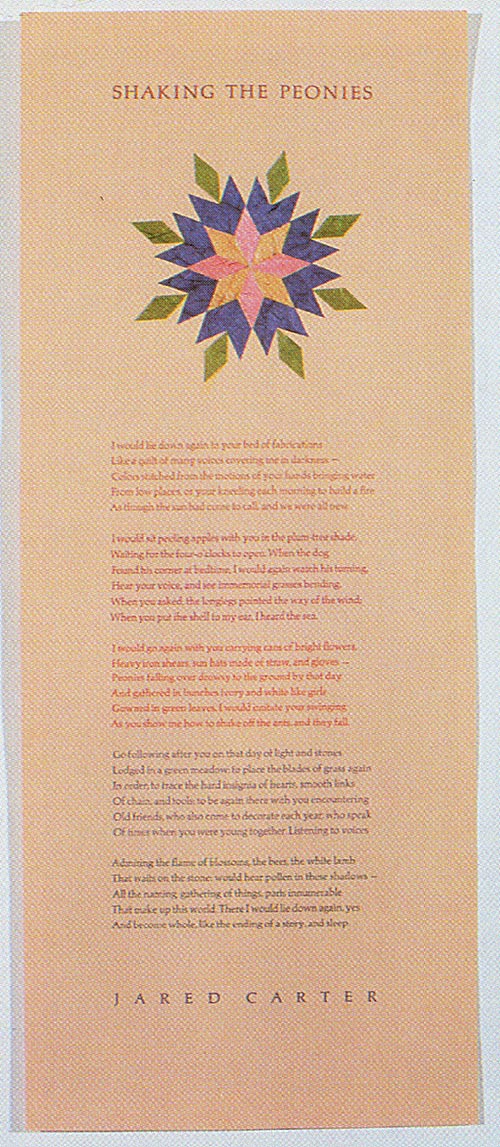
Priscilla Tetley & Derec Cowan | Canada
The Library
1991 Fine Printing/ Typographie 8.5 x 18 x 1 cm
| Accordian-fold book illustrated with 26 designs in wood type. The story of an infinite library. |
Reliure accordéon, 26 dessins imprimés en caractères de bois. L'histoire d'une bibliothèque illimitée. |

Priscilla Tetley & Derec Cowan | Canada
Mr. Lewis' Rabbit
1992 Fine Printing/ Typographie 17 x 23 x 1 cm
| Story of childhood experience by Derec Cowan, with 16 linoeuts, hard cover with linoeut design. | Une histoire d'enfanee de Deree Cowan illustrée de 16 gravures sur linoléum, couverture décorée de gravure sur linoléum. |
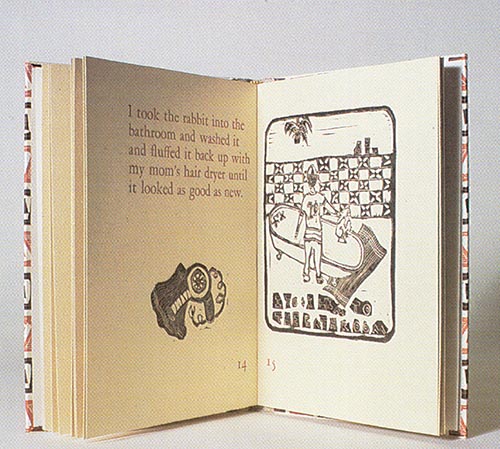
Michael Torosian | Canada
Homage: The Lumiere Press Collection
1991 Fine Printing/ Typographie 16 x 23 x 5 cm
| Boxed set of five limited edition books. | Série de cinq livres d'édition limitée, boîtier, |
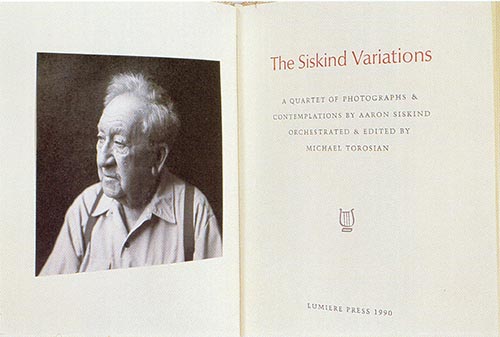
Claire Van Vliet | United States
Pandora's Box
1991 Fine Printing/ Typographie 50.2 x 36 cm
| Woven paper and cloth broadside of a text by Margaret Kauffman. | Placard de tissu et de papier tissés: texte de Margaret Kaufman. |
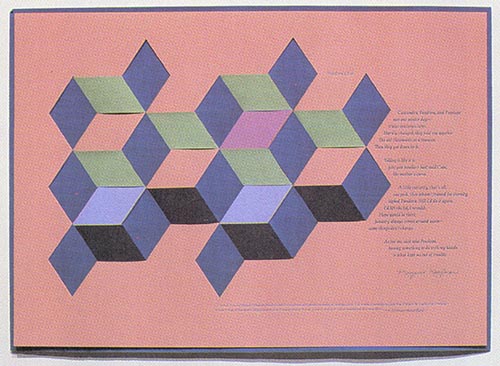
Wendy Cain | Canada
Open Book Series/Obscured Text #3
1992 Handmade Paper/ Papier main 72 x 95 cm
| Handmade paper, pulp spray, and painting technique. | Papier main, pulvérisation de pulpe, et peinture. |
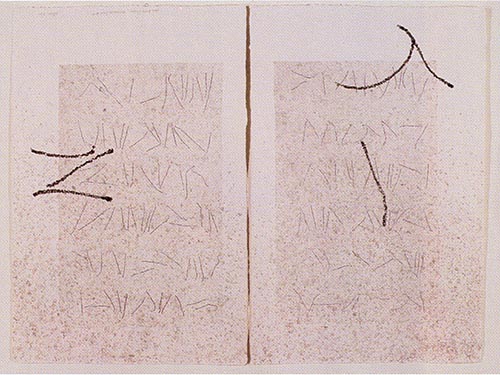
![]()
Wendy Cain | Canada
Open Book Series/Obscured Text #4
1992 Handmade Paper/ Papier main 72 x 95 cm
| Handmade paper, pulp spray, and painting technique. | Papier main, pulvérisation de pulpe, et peinture. |
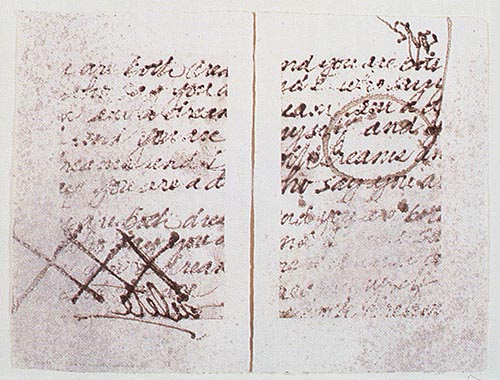
![]()
|
Karen Trask | Canada The Distance Between Two Halves 1991 Handmade Paper/ Papier main Lithography on hand-made paper./Lithographie sur papier main. |
Karen Trask | Canada The Poetry Cup 1990 Handmade Paper/ Papier main Text and image on hand made paper form two halves of a cup./Texte et image sur papier main, composant les deux parties d'une tasse. |
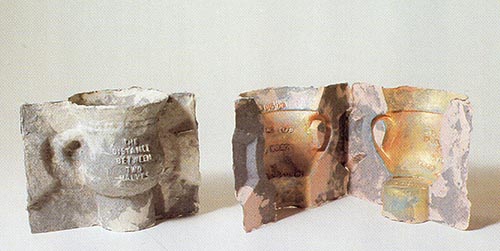
![]()
Claire Van Vliet | United States
Sappho
1990 Handmade Paper/ Papier main 36 x 5l cm
| Handmade paper broadside with relief print by Peter Schumann. | Placard de papier main, estampé en relief par Peter Schumann. |

![]()
Pamela Westhaver | Canada
A Paper Sampler
1992 Handmade Paper/ Papier main 16.4 x 23 x 2 cm
| Book of handmade paper using numerous plant materials. | Livre de papiers main composés de divers matériaux végétaux. |
